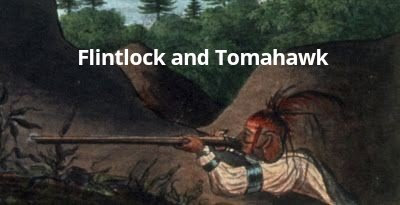Artist unknown, Homme Iroquois, late 18th century, Musée National des Beaux-Arts du Québec.
Saturday, 13 December 2025
Friday, 5 December 2025
Prince August 40mm
Thursday, 13 November 2025
Wednesday, 12 November 2025
War on the Turtle's Back
Tuesday, 4 November 2025
Today in 1791
St. Clair's defeat, also known as the Battle of the Wabash, the Battle of Wabash River or the Battle of a Thousand Slain,[3] was a battle fought on 4 November 1791 in the Northwest Territory of the United States. The U.S. Army faced the Northwestern Confederacy of Native Americans as part of the Northwest Indian War. It was "the most decisive defeat in the history of the American military"[4] and its largest defeat ever by Native Americans.[5]
Sunday, 2 November 2025
How Stands The Glass Around? (Why Soldiers Why?)
This song first appears in print in 1729. According to a story, probably apocryphal, it was sung by British General James Wolfe on the night before he was killed in the Battle of the Plains of Abraham at Quebec in 1759.
Saturday, 1 November 2025
Wednesday, 29 October 2025
Fort Ticonderoga's 1775 map
Learn more about the map (object ID 1992.16, photo by Gavin Ashworth, © Fort Ticonderoga) on the Ticonderoga Online Collections database: https://fortticonderoga.catalogaccess.com/archives/29569
Sunday, 26 October 2025
Battle of the Chateauguay
26th October 1813 – A combined force of British regulars, Canadian militia, and Mohawks defeat the Americans in the Battle of the Chateauguay.
 |
In Defence of their Homelands - Canada.ca Mohawk Warrior from Tyendinaga, Autumn 1813 (Painting by Ron Volstad (Department of National Defence)) |
Friday, 24 October 2025
Thursday, 23 October 2025
Hot Stuff - British Army Song
Written by Sergeant Ned Botwood of the 47th Regiment of Foot, before he was killed in the assault at Montmorency during Wolfe’s Quebec campaign in 1759.
Wednesday, 22 October 2025
Sunday, 19 October 2025
Thursday, 16 October 2025
Today in 1780
The Royalton raid was a British-led Indian raid in 1780 against various towns along the White River Valley in the Vermont Republic during the American Revolutionary War. It was the last major Indian raid in New England.[1]
Wednesday, 15 October 2025
Tuesday, 14 October 2025
Monday, 13 October 2025
Friday, 10 October 2025
Thursday, 9 October 2025
Tuesday, 7 October 2025
Battle of Bemis Heights (October 7)
Battles of Saratoga - Wikipedia
A decisive defeat for Burgoyne. A major turning point in the war.
Sunday, 5 October 2025
Battle of the Thames
The Battle of the Thames /ˈtɛmz/, also known as the Battle of Moraviantown, was an American victory over British forces and Tecumseh's Confederacy during the War of 1812. The battle took place on October 5, 1813, in Upper Canada near what is now Thamesville, Ontario. The British lost control of the Western District of Upper Canada as a result of the battle. Tecumseh was killed, and his confederacy collapsed.
Saturday, 4 October 2025
A Dialogue in Hades by chevalier de James Johnstone
Work dealing with Johnstone's time in Canada were printed in Quebec in 1887: The Campaign of 1760 in Canada and A dialogue in Hades: a parallel of military errors, of which the French and English armies were guilty, during the campaign of 1759, in Canada.[1]
"A Dialogue in Hades" by Chevalier de James Johnstone Johnstone is a historical account written in the late 19th century. This work presents a unique perspective on military strategies and mistakes made during the 1759 campaign in Canada, focusing particularly on the encounters between French and English forces. The dialogue features key military figures, notably General Wolfe and the Marquis de Montcalm, who discuss their experiences and the errors that led to their respective downfalls. The opening of the text introduces a captivating discourse between Wolfe and Montcalm in the afterlife. They reflect on their fateful encounters during the military campaign in Canada, discussing their respective strategies, the failures in communication and preparedness, and the tragic outcomes of their decisions. The two generals confront the biases of their nations regarding their legacies, as Wolfe receives posthumous accolades while Montcalm laments his unjust treatment. The dialogue method employed illustrates their contrasting viewpoints and provides readers with an insightful examination of leadership, fate, and historical interpretation in the realm of war.A Dialogue in Hades by chevalier de James Johnstone Johnstone | Project Gutenberg
Fort Ligonier
Final reminder about tomorrow's FREE program, The New American Revolution Film – One Hour Screener – Free Event! , going on tomorrow, Sunday, October 5 at 3 p.m. in our Center for History Education!
Thursday, 2 October 2025
Iroquois warrior
Artist unknown, Homme Iroquois, late 18th century, Musée National des Beaux-Arts du Québec.

-
Our colonial Marine unit gets some last minute instruction before going to fight the British. Pinterest for more.
-
This is the first stage of an excellent project. This is the corner tower of a recreation of the fort in the movie Drums Along the Mohawk...










.jfif)













.jfif)

.jfif)




